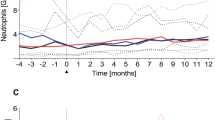Abstract
The suppression of lymphopoiesis and immune competence during the maintenance phase in children with acute lymphoblastic leukemia (ALL) and the occurrence of infectious complications remain an unexplored area. In this study we assessed lymphocyte subpopulation disturbances during maintenance for childhood ALL along with the incidence, type, and severity of infections that occur during that period in the absence of neutropenia. Twenty-eight children (13 boys, 15 girls) with ALL aged 3-14 years (median 7 years) and treated according to the ALL-BFM 90/95 protocol were studied during maintenance for ALL. Complete white blood cell (WBC) counts and peripheral blood lymphocyte (PBL) analyses were performed. Major lymphocyte subsets (CD19+, CD3+CD4+, CD3+CD8+, CD3-CD16+CD56+, CD45RA+, CD45RO+) and markers of T-cell activation (CD25, CD38, CD69, HLA-DR) were analyzed with flow cytometry. Serum immunoglobulin G (IgG), IgA, and IgM levels were measured by a nephelometric assay. All infectious episodes during the study period were recorded in detail. Additionally, 41 age-matched immunocompetent children were used as controls. Absolute WBC counts (median, 3627/µL) and PBL counts (median, 1206/µL) were significantly below the age-adjusted control values (7400/µL and 2673/µL, respectively; P < 0001). B-lymphocyte, total CD4+, and memory CD4+ (CD4+CD45RO+) subsets were also significantly decreased (33/µL versus 377/µL [P <.0001], 531/µL versus 1045/µL [P <.01], and 80/µL versus 299/µL [P <.001], respectively). Significantly lower immunoglobulin levels were found in all patients. Twenty-two of the 28 patients presented with 74 episodes of a variety of minor infections (mostly respiratory viral [39], skin [7], and gastrointestinal [3]), none demanding prolonged hospital treatment. Our findings demonstrate a profound immunosuppression throughout maintenance therapy in children with ALL that has no major clinical impact in terms of increased incidence or severity of systemic infections.
Similar content being viewed by others
References
Lee JW, Pizzo PA. Management of specific problems in children with leukemias and lymphomas. In: Patrick CC, ed. Infections in Immuno-compromised Infants and Children. New York, NY: Churchill Livingstone; 1992:195–214.
Pizzo PA Infectious complications in the child with cancer, I: pathophysiology of the compromised host and the initial evaluation and management of the febrile cancer patient. J Pediatr. 1981; 98:341–354.
Pizzo PA, Rubin M, Freifeld A, Wash TJ. The child with cancer and infection, I: empiric therapy for fever and neutropenia, and preventive strategies. J Pediatr. 1991;119:679–694.
Lex C, Korholz D, Kohlmuller B, et al. Infectious complications in children with acute lymphoblastic leukemia and T-cell lymphoma: a rationale for tailored supportive care. Support Care Cancer. 2001; 9:514–521.
Pizzo PA, Rubin M, Freifeld A, Walsh J. The child with cancer and infection, II: nonbacterial infections. J Pediatr. 1991;119:845–857.
Gross RA, Lee H, Wolff JA, Hall CB, Minnefore AB, Lazicki ME. Influenza immunization in immunosuppressed children. J Pediatr. 1978;92:30–35.
Polychronopoulou-Androulakaki S, Panagiotou JP, Kostaridou S, Kyratzopoulou A, Haidas S. Immune response of immunocompromised children with malignancies to a recombinant hepatitis B vaccine. Pediatr Hematol Oncol. 1996;13:425–431.
Lovat PE, Robinson JH, Windebank KP, Kernahan J, Watson JG. Serial study of T lymphocytes in childhood leukemia during remission. Pediatr Hematol Oncol. 1993;10:129–139.
Caver TE, Slobod KS, Flynn PM, et al. Profound abnormality of B/T lymphocyte ratio during chemotherapy for pediatric acute lymphoblastic leukemia. Leukemia. 1998;12:619–622.
Moritz B, Eder J, Meister B, Heitger A. Intact T-cell regenerative capacity in childhood acute lymphoblastic leukemia after remission induction therapy. Med Pediatr Oncol. 2001;36:283–289.
Katevas P, Lembesopoulos C, Kamitaki C, et al. Establishment of normal ranges of lymphocyte subpopulations in cord blood and in peripheral blood in infants and in children. Haema. 1999;2:145–151.
Erkeller-Yuksei FM, Deneys V, Yuksel B, et al. Age-related changes in human blood lymphocyte subpopulations. J Pediatr. 1992;120:216–222.
Pui C-H, Evans WE. Acute lymphoblastic leukemia. N Engl J Med. 1998;339:605–615.
Borzy MS, Ridgway D. Prolonged defects of interleukin-2 production, responsiveness, and receptor expression in patients with acute lymphoblastic leukemia. Blood. 1989;73:1608–1614.
Komada Y, Zhang SL, Zhou YW, et al. Cellular immunosuppression in children with acute lymphoblastic leukemia: effect of consolidation chemotherapy. Cancer Immunol Immunother. 1992;35:271–276.
Papadakis V, Panagiotou JP, Polychronopoulou-Androulakaki S, et al. Results of childhood acute lymphoblastic leukaemia treatment in Greek patients using a BFM-based protocol. Haema. 2003;6:208–216.
Alanco S, Pellinieri T-T, Salmi TV. Recovery of blood B-lymphocytes and serum immunoglobulins after chemotherapy for childhood acute lymphoblastic leukemia. Cancer. 1992;69:1481–1486.
Masur H, Ognibene FP, Yarchoan R, et al. CD4 counts as predictors of opportunistic pneumonias in human immunodeficiency virus (HIV) infection. Ann Intern Med. 1989;111:223–231.
Mackall CL, Fleisher TA, Brown MR, et al. Age, thymopoiesis, and CD4+ T-lymphocyte regeneration after intensive chemotherapy. N EnglJ Med. 1995;332:143–149.
Leino L, Lilius E-M, Nikoskelainen J, Pelliniemi TT, Rajamaki A. The reappearance of 10 differentiation antigens on peripheral blood lymphocytes after allogeneic bone marrow transplantation. Bone Marrow Transplant. 1991;8:339–344.
Smith S, Schiffman G, Karayalcin G, Bonagura V. Immunodeficiency in long-term survivors of acute lymphoblastic leukemia treated with Berlin-Frankfurt-Munster therapy. J Pediatr. 1995;127:68–75.
Layward L, Levinsky RJ, Butler M. Long-term abnormalities in B and T lymphocyte function in children following treatment for acute lymphoblastic leukemia. Br J Haematol. 1981;49:251–258.
Hayns BF, Fauci AS. The differential effect of in vivo hydrocortisone on the kinetics of subpopulations of human peripheral blood thymus-derived lymphocyte. J Clin Invest. 1978;61:703–707.
Boldt DH, Von Hoff DD, Kuhn JG, Hersh M. Effects on human peripheral lymphocytes of in vivo administration of 9-beta-D- arabinofuranosy1-2-fluoradenine-5’-monophosphate (NSC 312887), a new purine antimetabolite. Cancer Res. 1984;144:4661–4666.
Polychronopoulou S, Koutroumba P. Telomere length and telomerase activity variations with advancing age and potential role in childhood malignancies. J Pediatr Hematol Oncol. 2004;26:342–350.
Son NH, Murray SH, Yanovski J, Hodes RJ, Weng N. Lineage- specific telomere shortening and unaltered capacity for telomerase expression in human T and B lymphocytes with age. J Immunol. 2000;165:1191–1196.
Author information
Authors and Affiliations
Corresponding author
About this article
Cite this article
Kostaridou, S., Polychronopoulou, S., Psarra, K. et al. Decrease of CD4+ and B-Lymphocyte Populations Is Not Associated with Severe Infectious Complications in Children with Acute Lymphoblastic Leukemia during Maintenance. Int J Hematol 80, 354–360 (2004). https://doi.org/10.1532/IJH97.E0317
Received:
Revised:
Accepted:
Published:
Issue Date:
DOI: https://doi.org/10.1532/IJH97.E0317




